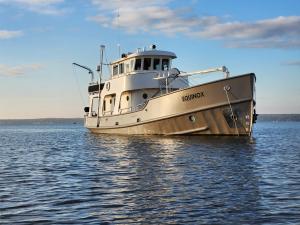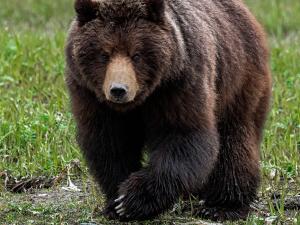Tongass National Forest
The scenic beauty and recreation opportunities inside the United States' largest national forest are vibrant and abundant.
Dense green forests, dramatic coastline dotted with islands and waterfalls, and tidewater glaciers spilling down from the mountains make up the varied landscapes of Tongass National Forest, spanning 500 miles across Alaska’s Inside Passage region. Treasured by visitors and locals alike, the Tongass is the largest intact temperate rainforest in the world and the largest national forest in the United States.
The national forest received its name from the Tongass Clan of the Tlingit Peoples, who, along with the Haida and Tsimshian Peoples, have lived in this area for thousands of years. More than 80 percent of Southeast Alaska is in Tongass, spanning 11,000 miles of coastline, and home to over 70,000 people living in 32 communities, including Alaska’s state capital, Juneau.
THINGS TO DO
The Tongass contains 19 wilderness areas, including the 545-sq-mile Russell Fjord Wilderness, as well as Admiralty Island National Monument and Misty Fjords National Monument. Recreation opportunities here are abundant, including hiking, camping, public use cabins, fishing, kayaking, wildlife viewing, glacier viewing, and more.
Visitors can hike miles of maintained trails through dense forests, alpine meadows, or on boardwalks through peat bogs called muskegs. In the Juneau area, the U.S. Forest Service maintains more than 20 trails including five that end at a glacier. West Glacier Trail to Mendenhall Glacier is known as one of the most spectacular hikes in the Inside Passage. Other activities include ranger-led tours of El Capitan Cave on Prince of Wales Island, kayaking in Tracy Arm-Fords Terror Wilderness, and canoeing and portaging a chain of lakes across Admiralty Island.
Bear viewing is also very popular in Tongass. During the salmon spawning season, visitors gather at bear viewing sites at Fish Creek near Hyder, Anan Creek near Wrangell, Pack Creek Bear Viewing Area on Admiralty Island (home to over 1,500 bears), and Steep Creek at Juneau's Mendenhall Glacier. Equally popular are whale watching tours to view migrating humpback whales. Charter boat operators in Juneau, Sitka, and Petersburg offer such tours while Forest Service staff on the Alaska Marine Highway help passengers spot wildlife, including whales.
Scattered throughout the forest, usually on remote lakes or bays, are 150 Forest Service cabins that can be reserved in advance. The vast majority are accessed by float plane, but five in Juneau and one in Petersburg can be reached on foot. Many communities in the Inside Passage have one if not several Forest Service campgrounds set in scenic locations in the Tongass.
WILDLIFE
Wildlife is abundant throughout the Tongass National Forest. Sitka blacktail deer and its two main predators, wolves and brown bears, inhabit this area. Black bears are common as well as mountain goats and moose. Marine mammals found along the coastal waters include Dall’s and harbor porpoises, harbor seals, sea otters, orcas, and humpback and minke whales. The waters teem with fish including halibut and all five species of Pacific salmon. More bald eagles live in this region than in any other place in the world.
LANDSCAPE
The Tongass is bordered by the Pacific Ocean and the Coast Mountains, which extend across the Canadian border into British Columbia. The vast coastal terrain is the world’s largest temperate rainforest, and its canopy consists of towering hemlock, Sitka spruce, and red and yellow cedar, and alder. Moss and ferns cover the ground, and lichens drape many trees.
Though home to the world's largest temperate rainforest, almost half of Tongass is covered by ice, water, wetlands, and rock. Its most famous ice floe is the Mendenhall Glacier, Alaska's famous "drive-in glacier," because it is only 13 miles from downtown Juneau along a paved road.
A boat ride from Petersburg or Wrangell brings you near the face of LeConte Glacier, the southernmost tidewater glacier on the continent. Just 30 miles north of Yakutat is the 76-mile-long Hubbard Glacier, the longest tidewater glacier in the world and easily one of Alaska's most active. The rip tides and currents that flow in front of the 8-mile-wide glacier are so strong they cause Hubbard to calve almost continuously.
HISTORY
The area is the traditional homeland of the Tlingit, Haida, and Tsimshian Peoples, who have lived here for thousands of years. The forest was designated in 1902 as the Alexander Archipelago Forest Reserve by President Theodore Roosevelt. In 1908 the forest was renamed and expanded, and today the 16.9 million-acre Tongass National Forest stretches from the Pacific Ocean to the vast inland ice fields that border British Columbia, and from the southern tip of Prince of Wales Island to Malaspina Glacier 500 miles to the north.
FACILITIES AND CAMPING
Tongass National Forest offers outstanding recreation opportunities and facilities. Scattered throughout the forest are 150 Forest Service cabins that can be reserved in advance. There are also 20 designating campgrounds or camping areas within the forest, plus endless opportunities for dispersed and backcountry camping.
There are three visitor centers with displays, exhibits, and information on exploring the vast area: Southeast Alaska Discovery Center in Ketchikan, Mendenhall Glacier Visitor Center in Juneau, and the Petersburg Visitor Information Center in Petersburg. There are also additional Ranger District offices located in Craig, Hoonah, Sitka, Thorne Bay, Wrangell, and Yakutat.
GETTING HERE
Because of its vast size, Tongass National Forest is accessible from several communities in the Inside Passage. Visitors can explore these areas independently, join a guided trip, or explore as part of an excursion that can be added to cruise itineraries.
There is no mainland road access to most of Alaska's Inside Passage. There is daily flight service from Seattle and Anchorage to Sitka, Ketchikan, Petersburg, Wrangell, and Juneau, while scheduled air taxi service is available to many other smaller Inside Passage communities. Year-round Alaska Marine Highway service connects many communities to Bellingham, WA, and Prince Rupert, B.C., Canada.
For more information, visit the Tongass National Forest website.
Plan Your Trip
Equinox offers custom multiday adventure cruises based out of historic Sitka, Alaska. Owner/operators Cameo and Brooks take groups of up to 6...
Equinox offers custom multiday adventure cruises based out of historic Sitka, Alaska. Owner/operators Cameo and Brooks take groups of up to 6...
Equinox offers private adventure cruises based out of historic Sitka, Alaska. Owner/operators Cameo and Brooks invite you and 5 friends to join...
Equinox offers custom, multiday fishing charters based out of Sitka, Alaska. Owner/operators Cameo and Brooks take groups of up to 6 guests on 5...
UnCruise defines adventure in Alaska. Moss and moose, thunderous glaciers and tufted puffins—Alaska is full of surprises. The birthplace of...
We are the premier provider of wilderness brown bear viewing in Southeast Alaska! Imagine watching bears catch salmon, forage along the beach...

Local Climate & Weather
For Alaska's day-to-day weather, it’s best to plan for a bit of everything. Learn more about weather in this area.

Travel Inspiration
#TravelAlaska
#TravelAlaska
 @realfamilytravelswithsara
@realfamilytravelswithsara
 @realfamilytravelswithsara
@realfamilytravelswithsara
 @yourwishtravelco
@yourwishtravelco
 @realfamilytravelswithsara
@realfamilytravelswithsara
 @realfamilytravelswithsara
@realfamilytravelswithsara






















